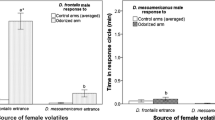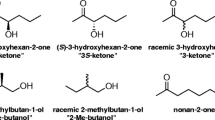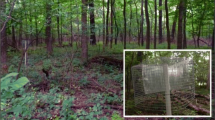Abstract
Pissodes strobi, P. approximatus, andP. nemorensis are sibling species of pine weevils that can hybridize in the laboratory but are presumed to be reproductively isolated in nature. Males of all three species produce the terpenoids grandisol and grandisal; these compounds serve as an aggregation pheromone forP. approximatus andP. nemorensis when deployed with odors from pine bolts. A series of field experiments examined the possibility of cross-attraction among the three species. Tests in New York and Florida found that parapatrically distributedP. approximatus andP. nemorensis were cross-attractive, but different photoperiodic conditioning was required for pheromone production in males of the two species. Long-day pheromone production (P. approximatus-type.) was inherited in interspecific hybrids. Other tests showed thatP. strobi males, or hybrid males from crosses ofP. strobi withP. approximatus, were not attractive to sympatricP. approximatus. When the response ofP. strobi was assessed to males of eitherP. strobi orP. approximatus confined on white pine leaders (the breeding site ofP. strobi), no evidence of cross-attraction or pheromone activity was found;P. strobi were caught in equal numbers onP. strobi-baited leaders,P. approximatus-baited leaders, and unbaited leaders. Tests of interspecific interactions found that maleP. strobi produce an allelochemical signal that interrupts the response ofP. approximatus to its natural or synthetic aggregation pheromone. This interspecific response is apparently adaptive for members of both species (classified as an allomone-kairomone or synomone) because it may ultimately serve to prevent interspecific matings that would lower the fitness of the parents.
Similar content being viewed by others
References
Atkinson, T.H. 1979. Bionomics ofPissodes nemorensis (Coleoptera: Curculionidae) in North Florida. PhD thesis, University of Florida. Gainesville, Florida. 100 pp.
Baker, W.L. 1972. Eastern Forest Insects. U.S. Dept. of Agric. Forest Service Misc. Publ. No. 1175. 642 pp.
Birch, M.C., Light, D.M., Wood, D.L., Browne, L.E., Silverstein, R.M., Bergot, B.J., Ohloff, G., West, J.R., andYoung, J.C. 1980. Pheromonal attraction and allomonal interruption ofIps pini in California by the two enantiomers of ipsdienol.J. Chem. Ecol. 6:703–717.
Booth, D.C. 1978. The chemical ecology and reproductive isolation of the white pine weevil,Pissodes strobi (Peck) and the northern pine weevil,P. approximatus Hopkins (Coleoptera: Curculionidae). PhD thesis, State University of New York, College of Environmental Science and Forestry. Syracuse, New York. 100 pp.
Booth, D.C., andLanier, G.N. 1974. Evidence of an aggregating pheromone inPissodes approximatus andP. strobi.Ann. Entomol. Soc. Am. 67:992–994.
Booth, D.C., Phillips, T.W., Claesson, A., Silverstein, R.M., Lanier, G.N., andWest, J.R. 1983. Aggregation pheromone components of two species ofPissodes weevils (Coleoptera: Curculionidae): Isolation, identification, and field activity.J. Chem. Ecol. 9:1–12.
Borden, J.H. 1977. Behavioral responses of Coleoptera to pheromones, allomones, and kairomones, pp. 169–198,in H.H. Shorey and J.J. McKelvey (eds.). Chemical Control of Insect Behavior. Wiley, New York.
Borden, J.H., Handley, J.R., Mclean, J.A., Silverstein, R.M. Chong, L., Slessor, K.N., Johnston, B.D., andSchuler, H.R. 1980. Enantiomer based specificity in pheromone communication by two sympatricGnathotrichus species (Coleoptera: Scolytidae).J. Chem. Ecol. 6:445–456.
Finnegan, R.J. 1958. The pine weevilPissodes approximatus Hopkins in sourthern Ontario.Can. Entomol. 90:340–354.
Fontaine, M.S. 1981. Reproductive ecology of the deodar weevil,Pissodes nemorensis (Coleoptera: Curculionidae), in north Florida. MS thesis, University of Florida. Gainesville, Florida. 100 pp.
Fontaine, M.S., andFoltz, J.L. 1982. Field studies of a male-released aggregation pheromonein Pissodes nemorensis.Environ. Entomol. 11:881–883.
Fontaine, M.S., Foltz, J.L., andNation, J.L. 1983. Reproductive anatomy and seasonal development of the deodar weevil,Pissodes nemorensis (Coleoptera: Curculionidae) in north Florida.Environ. Entomol. 12:687–691.
Germar, E.F. 1824. Insectorum species novae aut minus cognitae, descriptionibus illustratae. Vol. 1. pp. 316–319.
Godwin, P.A., andOdell, T.M. 1967. Experimental hybridization ofPissodes strobi andP. approximatus (Coleoptera: Curculionidae).Ann. Entomol. Soc. Am. 60:55–58.
Godwin, P.A., Valentine, H.T., andOdell, T.M. 1982. Identification ofPissodes strobi, P. approximatus andP. nemorensis (Coleoptera: Curculionidae) using descriminant analysis.Ann. Entomol. Soc. Am. 75:599–604.
Hard, J.S. 1962. Bionomic ivestigations of the northern pine weevil,Pissodes approximatus Hopkins (Coleoptera: Curculionidae) MS thesis, New York State College of Forestry. Syracuse, New York. 59 pp.
Harris, L.J., Borden, J.H., Pierce, H.D., Jr., andOehlschlager, A.C. 1983. Cortical resin monoterpenes in Sitka spruce and resistance by the white pine weevil,Pissodes strobi (Coleoptera: Curculionidae).Can. J. For. Res. 13:350–352.
Hopkins, A.D. 1911. Contributions toward a monograph of the bark-weevils of the genusPissodes. U.S. Dept. of Agric. Entomol. Bull. 20 (Tech. Ser.). Part 1.
MacAloney, H.J. 1930. The white pine weevil (Pissodes strobi Peck) its biology and control. Bull. N.Y. State Coll. For. 3:1–87.
Nordlund, D.A., andLewis, W.J. 1976. Terminology of chemical releasing stimuli in intra-specific and interspecific interactions.J. Chem. Ecol. 2:211–220.
Odell, T.M.,Godwin, P.A., andZerillo, R.T. (unpublished ms.). The ethological relationship ofPissodes strobi (Peck) andP. approximatus Hopkins under restricted field conditions. Unpublished office report 4500-FS-2201. Forest Insect and Disease Laboratory. U.S. Forest Service. Hamden, Connecticut. 14 pp.
Phillips, T.W. 1981. Aspects of host preference and chemically mediated aggregation inPissodes strobi (Peck) andP. approximatus Hopkins (Coleoptera: Curculionidae). MS. thesis, State University of New York College of Environmental Science and Forestry. Syracuse, NY. 94 pp.
Phillips, T.W. 1984. Ecology and systematics ofPissodes sibling species. PhD thesis, State University of New York College of Environmental Science and Forestry. Syracuse, New York. 204 pp.
Phillips, T.W., andLanier, G.N. 1983. Biosystematics ofPissodes Germar (Coleoptera: Curculionidae): feeding preference and breeding site specificity inP. strobi andP. approximatus.Can. Entomol. 115:1627–1636.
Phillips, T.W., West, J.R., Foltz, J.L., Silverstein, R.M., andLanier, G.N. 1984. Aggregation pheromone of the deodar weevil,Pissodes nemorensis (Coleoptera: Curculionidae): Isolation and activity of grandisol and grandisal.J. Chem. Ecol. 10:1417–1423.
Phillips, T.W.,Teale, S.A., andLanier, G.N. 1986. Biosystematics ofPissodes Germar (Coleoptera: Curculionidae): Seasonally, morphology, and synonymy ofP. approximatus andP. nemorensis. Can. Entomol. Submitted.
Silverstein, R.M. 1979. Enantiomeric composition and bioactivity of chiral semiochemicals in insects, pp. 133–146,in F.J. Ritter (ed.). Chemical Ecology: Odour Communication in Animals. Elsevier/North Holland, Amsterdam.
Smith, S.G. 1973. Chromosomal polymorphism and interspecific relationships inPissodes weevils: Additional cytogenetic evidence of synonymy.Can. J. Genet. Cytol. 15:83–100.
Smith, S.G., andSugden, B.A. 1969. Host trees and breeding sites of native North AmericanPissodes bark weevils, with a note on synonymy.Ann. Entomol. Soc. Am. 62:146–148.
Tauber, M.J., andTauber, C.A. 1976. Insect seasonality, diapause maintenance, and postdiapause development.Annu. Rev. Entomol. 21:81–107.
VanderSar, T.J.D., andBorden, J.H. 1977a. Visual orientation ofPissodes strobi Peck (Coleoptera: Curculionidae) in relation to host selection behavior.Can. J. Zool. 55:2042–2049.
VanderSar, T.J.D., andBorden, J.H. 1977b. Role of geotaxis and phototaxis in the feeding and oviposition behavior of overwinteredPissodes strobi. Environ.Entomol. 6:743–749.
Wood D.L. 1982. The role of pheromones, kairomones, and allomones in the host selection and colonization behavior of bark beetles.Annu. Rev. Entomol. 27:411–446.
Author information
Authors and Affiliations
Rights and permissions
About this article
Cite this article
Phillips, T.W., Lanier, G.N. Interspecific activity of semiochemicals among sibling species ofPissodes (Coleoptera: Curculionidae). J Chem Ecol 12, 1587–1601 (1986). https://doi.org/10.1007/BF01020266
Received:
Accepted:
Issue Date:
DOI: https://doi.org/10.1007/BF01020266




